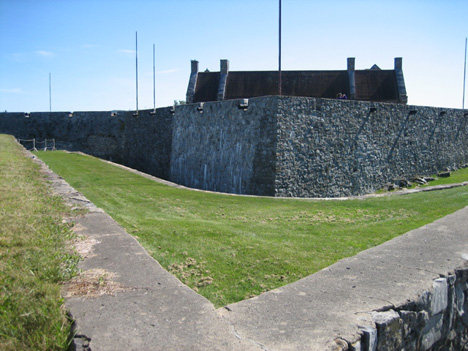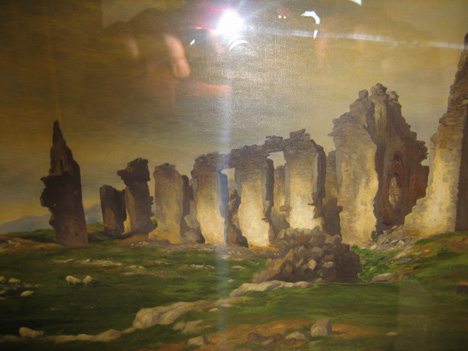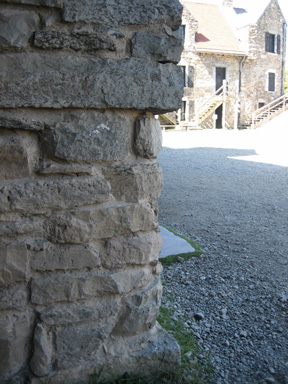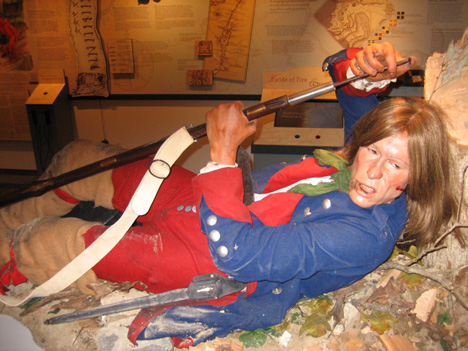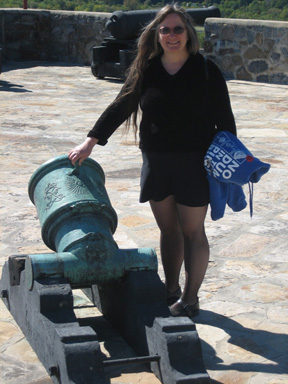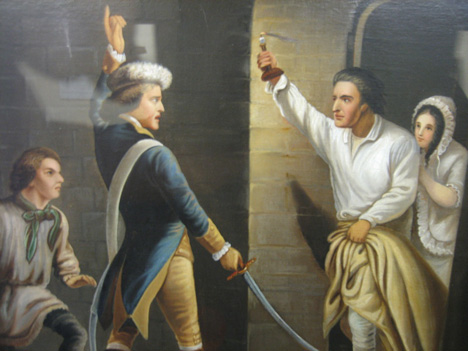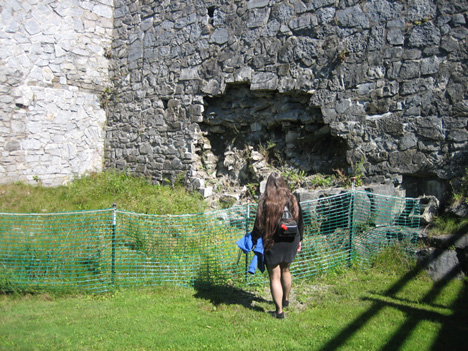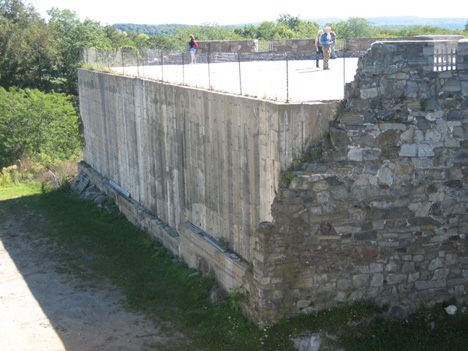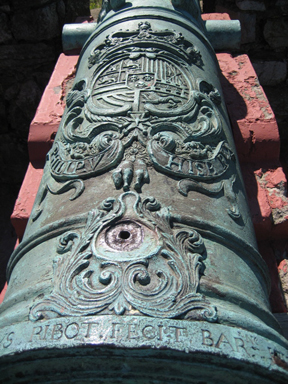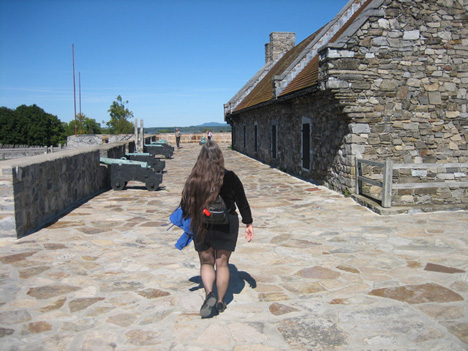albanyweblog.com
Updated
November 30, 2009
A weblog about the politics and affairs of the old and glorious City of Albany, New York, USA. Articles written and disseminated from Albany's beautiful and historic South End by Daniel Van Riper. If you wish to make a response, have anything to add or would like to make an empty threat, please contact me.
Click on this link to add this site to your RSS feed.
Now With Comments! Check the bottom of the page and try them out.
November 30, 2009
A Visit To Fort Ticonderoga
A warm weather Sunday visit to remind everybody that our nation is built upon Liberal values and that winter will not last forever
Now that the weather is finally getting cold, I want to tell you about a trip The Wife and I made this past September to Fort Ticonderoga. This was back when the days were full of sunshine and happiness. Ticonderoga is about a two hour drive from Albany, up the Northway to Exit 28 and another 20 miles straight east to the Vermont border. The fort sits on the three and a half mile La Chute River, the waterway that connects Lake George to Lake Champlain.
If you’ve never been to Fort Ticonderoga, I’ll go so far as to say that if you presume to call yourself a patriotic American then you need to go up there. In these late days of our rapidly declining republic, we fat lazy ignorant descendants of the real patriots desperately need to be reminded why we still have some of the rights and freedoms that are laid out for all to see in the Declaration of Independence and the Bill of Rights, rights that we are happily allowing to be taken away from us.
Fort Ticonderoga is the site of the very first victory by the rebels in the American Revolution. This little local action was initiated by the local people without authorization by distant command, yet it led to several victories that put the Revolution on solid ground, which in turn led to our freedom from foreign nations and from their corporations.
The Fort Ticonderoga that The Wife and I visited is a reproduction of the original, except for a few foundation stones the old fort is long gone. It seems that the original fort was badly built and poorly designed, and fell apart long ago. When I first heard this I felt cheated, why the hell were we wasting time looking at a cheap knockoff of a mistake? But after I learned about the fort’s history, I realized that the mistakes in construction and the attempts to rebuild it are all very much a part of Ticonderoga’s significance.
The fort was begun in 1755 by the French. The British and the French fought over it and the two world empires exchanged control of the fort several times before the British took control of most of North America after the Treaty of Utrecht in 1763. Later in the 1770s the fort was captured twice by the American revolutionaries, both times without serious fighting. But both captures were very central to the success of the revolution.
After the Revolutionary War the fort lost it’s military significance and was allowed to fall into ruin. The harsh weather of the area, the freezing and thawing rapidly tore apart the stone and masonry. Actually, the original masonry and construction techniques were considered substandard back even in the 1700s. The guys who built and designed the fort were punished for their incompetence. This makes accurate historical reproduction a frustrating continuation of original error.
The ruination was assisted by local farmers who regularly helped themselves to what they saw as ready building materials. By the 1820s the fort had become a romantic rubble beloved of the Hudson River school of art. About this time, fortunately for us today, the land around the fort fell to a private owner who sought to preserve the remains as a tourist destination. Finally in the early 20th Century work was begun to restore the fort as authentically as possible according to extensive surviving records, a century’s worth of effort that is only approaching completion today.
After the battles of Lexington and Concord in 1775 the revolutionaries laid siege to the British army in Boston. The only communication the British had with the outside world was by water. (Follow me here, this is important.) Word of the siege quickly spread inland to the free farmers of Vermont. Without hesitation the great and glorious hero Ethan Allen led these Vermont farmers, who called themselves the Green Mountain Boys, on an expedition to capture Fort Ticonderoga.
Stones Are Original, Square Stones
At Top Are NewAh, Ethan Allen. Many people know that during the Revolution he led Vermont as an independent republic. But few folks know that as a nation Vermont militarily invaded New York, conquering a 90 mile strip running north from the Massachusetts border including part of Rensselaer County. At the same time Vermont forcibly annexed the east bank of the Connecticut River from New Hampshire Both conquests were enthusiastically supported by the local populations of the occupied territories.
The elite feudal Patroons of Albany sent an army composed mostly of poor tenant farmers to repel the invaders from New York and conquer Vermont, which they claimed as their own personal possession. The two armies exchanged shots across the Hoosick River, the ‘battle’ produced no serious casualties. After this exchange the tenant farmers of New York refused to fight anymore and returned to Albany, leaving the occupied land to the invaders.
George Washington himself negotiated a withdrawal from the occupied territories, in exchange he promised to do all he could to allow Vermont to become a state in the new union. But General Washington could not counter the influence of the Albany Patroons in the Continental Congress and his efforts failed. Despite providing an important contingent to the Continental Army throughout the Revolution, Vermont was not admitted as the 14th state until 1793 after the Albany Patroons grudgingly gave up their claims.
At The MuseumAll that came later. In May of 1775 Ethan Allen and the Green Mountain Boys (with a fuming and furious Benedict Arnold in tow) approached Fort Ticonderoga. They found the isolated fort already half in ruins from the weather, which has been hard on the substandard construction throughout the fort’s history. Most of the 48 British manning the fort were ‘invalides,’ old or disabled soldiers assigned to light duty. The fort had lost it’s strategic importance after 1763, that spring its commander had not yet heard about the outbreak of revolution in Boston.
It’s hard for us moderns with our instantaneous communication techniques to understand how the occupants of Ticonderoga, at little more than 200 miles away, could not have heard about the Earth shaking popular uprising in Boston.
You see, the British had lost control of the American countryside, the same way centuries later first the British then the Soviets and now the US lost control of the rebellious countryside of Afghanistan. To send word to Ticonderoga, the British commander in Boston, General Gage, had to send a ship to Canada that carried specific orders to fortify the isolated outpost at Ticonderoga. This communiqué arrived in Quebec several weeks after the wilderness outpost down south had fallen to the rebel farmers.
It was this long standing problem of ineffective misrule from an absurd distance that had originally caused the American ‘colonists’ to chafe under British domination. As a matter of strict policy the English monarchy had no intention of granting the Colonies any sort of local autonomy. This was because the English considered the Colonies nothing more than a source of raw materials, thus they refused to cede any control that might cut into their apparent profits.
London’s attempted solution to this problem was to award local control of the Colonies to the East India Company, a monopolistic international corporation structured very much like the corporations we all chafe under today. Like all modern transnational corporations East India existed for one purpose and one purpose only: to secure a profit for itself and it’s shareholders by any means necessary. Almost all of these shareholders were upper class elite nobility, London’s equivalent of Albany’s elite Patroons.
The British government granted the East India Company effective control of commerce in North America along with the power to enforce this control anyway it saw fit. It was the further attempts by London to transfer the power of taxation to the East India Company that sparked the Boston Tea Party and the riots against the Stamp Act. Attempts by the government to enforce the corporate decrees ultimately led to armed resistance, which after much fighting and deprivation led to freedom from corporate power.
Ethan Allen and the Green Mountain Boys barged into Fort Ticonderoga and captured it without causing any casualties or even firing a shot. It really wasn’t much of a battle, but then, Ethan Allen was known for achieving victory with little or no bloodshed. With drawn sword he personally rousted out the sleeping British commander from his quarters. Official accounts have Allen calling for the Captain to surrender ‘In the name of the great Jehovah and the Continental Congress’ which has a real nice ring to it. But the more likely account is that he hollered through the door, ‘Come out you damned old rat!’
What made this apparent comical scene an event of world changing importance was an idea floated a few months later by a former bookstore clerk in his twenties named Henry Knox. Impressed with his knowledge of artillery, George Washington had made Knox a Colonel in the Continental Army. After Washington took command of the siege of Boston, Colonel Knox suggested bringing the captured cannons from Ticonderoga to Boston. As Wikipedia put it:
Knox was eventually given the assignment to transport weapons from Ticonderoga to Cambridge. Knox went to Ticonderoga in November 1775, and, over the course of 3 winter months, moved 60 tons of cannons and other armaments by boat, horse and ox-drawn sledges, and manpower, along poor-quality roads, across two semi-frozen rivers, and through the forests and swamps of the lightly-inhabited Berkshires to the Boston area. Historian Victor Brooks has called Knox's feat "one of the most stupendous feats of logistics" of the entire war.
With the Ticonderoga cannons in place on the heights above Boston and firing thunder onto the City below, the surprised British were forced to abandon Boston to the Rebels. The day that the corporatist army fled, March 17, which most of us know as St. Patrick’s Day, is a real holiday in Boston called Evacuation Day.
Later in the summer of 1777, General Arthur St. Clair made the entirely correct decision to abandon Fort Ticonderoga to British General Burgoyne’s much larger army advancing on Albany from Canada. St. Clair’s force joined the larger American force at Bemis Heights in Schuylerville (the so-called Battle of Saratoga,) which resulted in a resounding victory over the corporatist army that is considered one of the most significant battles in world history. This was a battle fought specifically to defend our own City of Albany.
General St. Clair was publicly condemned and court marshaled for abandoning Fort Ticonderoga, but eventually was exonerated. He understood full well that not only was the fort unlikely to hold up against sustained cannon fire, it was located in the most vulnerable place in the area! For starters, there are nearby heights from which cannons could casually blast the fort to rubble. As The Wife and I approached the fort on foot from the parking lot, I noticed to my puzzlement that the roof lines of the buildings were well above the walls. I thought to myself, aren’t those roofs unprotected from cannon that are sitting on the ground?
St. Clair, surrounded on three sides by the much larger British force, took the last opportunity to move his troops out of the fort before they were slaughtered. I asked the guides at the fort about these things, the crumbling mortar, the bad position of the fort, the high roof lines. Oddly, they gave me evasive answers, even pretending my questions were too esoteric to answer. Only after I got home and looked up Fort Ticonderoga online did I find out about these fatal problems that had so much effect on history.
I can’t imagine why the people who run the fort have chosen to excise these important details from their narrative. Do they believe the public will think less of their fort if people learn that it was a badly built and poorly designed? And yet it was these very problems that caused this fort to change hands so often in such a short time between three nations (four if you count Vermont.) This kind of alteration of the facts by deletion lessens the authenticity of the experience of visiting this monument.
The Caribbean, The Original Cannons
Went To BostonWe could see how the walls that had been built to historically accurate specifications and materials have decayed horribly due to frost. In recent years the walls are being rebuilt as poured concrete blocks and decorated with rough stone. Thus the walls will look like the original, but now they will endure. Hopefully they will, we’ll see.
I think this is very interesting in itself, a variation on the old Theseus’ Ship question. If you take a building, and over time in the course of routine maintenance you replace every stick and stone that needs replacement, faithfully keeping to the same design, is it the same building? Can we say that it is truly historical if it is not composed of the original materials?
If the answer to that question is yes, it is still the same building, then how much variation in the design can you get away with before the building is no longer recognizable as ‘authentic’? The keepers of Ticonderoga spent much of the 20th century faithfully reproducing the original walls with the original mortar only to see their painstaking efforts crumble repeatedly. It’s easy to see why they would grow tired of repeating the same historical mistakes.
But isn’t building walls of poured concrete decorated with stones dangerously close to fakery, a step over the line into illusion and showmanship? Maybe, but I prefer to see this rebuilding as a learning process, attempts to get it right and make the fort last. Concrete is more permanent than movie sets. If nothing else this effort to rebuild and preserve the fort is a reflection of the great liberal ideals upon which our nation is built, ideals we are letting slip through our fingers like crumbled mortar.
I suppose I could draw parallels between the rebuilding of Fort Ticonderoga and of the progress of life itself, or of civilizations. Perhaps I could trace a tortuous metaphor concerning the degeneration of our precious republic into the tottering empire of today, disintegrating at the hands of foreign corporations. But that’s too much work. I’d rather sit next to the radiator and leave such ponderings for spring.
Prior Post * * * Next Post
Comments:
If you are having difficulties posting a comment, please email Daniel Van Riper. We are experimenting with our spam filters, and we do not want to exclude any legitimate commenters, just spammers!
Add a comment, if you like :
Prior Post * * * Next Post
This site maintained by Lynne Jackson of Jackson's Computer Services.

